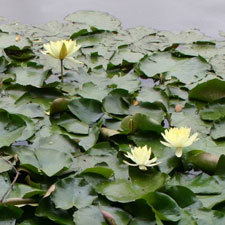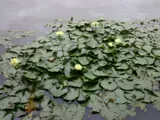 Mexican water lily
Mexican water lily
Common name: Mexican water lily; Banana lily
Botanical name: Nymphaea mexicana
Management programme: Advisory
Originally from Mexico and southern USA. Introduced to New Zealand as an ornamental pond plant and became naturalised in 1982.
Why is it a pest?
It forms dense mats of floating leaves over large areas, clogging waterways, shading out other plants and obstructing recreational water users.
Where is it found?
It is found in still freshwater bodies, particularly ponds, sheltered sections of lakes and still sections of rivers and streams.
What does it look like?
- A bottom rooted aquatic plant, similar to other water lilies, with vertical underwater rhizomes and round heart-shaped floating leaves (up to 25cm) on long stalks.
- Mature leaves have brown blotches on the upper surface and are mainly purple underneath.
- Star-shaped flowers are pale-yellow (October to December) with many veined petals and produce seeds.
What are the rules?
Advisory
Council does not enforce the control of advisory species. It is landowner/occupier responsibility to manage these pests. Council may provide advice on how to manage or control advisory species if required.
How do you get rid of it?
Begin control at the upstream end of the infestation and work downstream.
- Dig out/mechanical removal.
- Spraying, target emergent foliage.
CAUTION: When using herbicide please READ THE LABEL thoroughly to ensure that all instructions and safety requirements are followed.
Read more on pest control guidelines and regulations
Images

